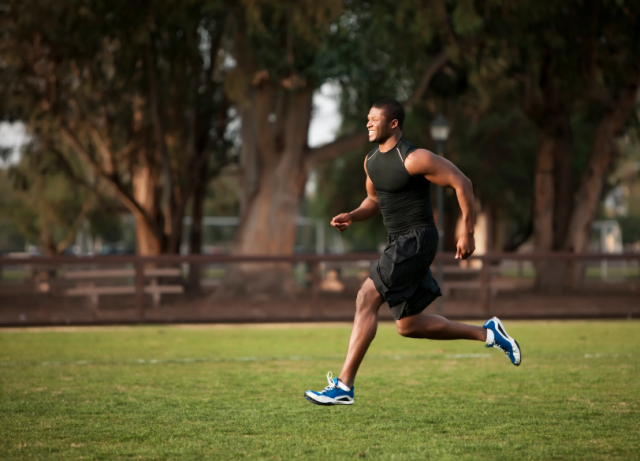
Two weeks ago found me feeling sorry for myself on Twitter, complaining about my slow-for-me mile time. When I asked for tips to run a faster mile I got a ton of good information. (And also a throw-down – Reader Taylor challenged me to a race duel. He kicked my trash. Technically I owe him a smoothie but knowing how disgusting my shakes are I’m pretty sure he’s going to pass on that.) Speedy runners and blog friends Adam from The Boring Runner and Tricia from Endurance Isn’t Only Physical took me under their well-muscled wing.
While the tips didn’t help me then – I was looking to improve my mile time in, like, 3 days (instant gratification!) for the fit blogger competition – they certainly are helping me now. Today I ran a mile in 5 minutes! … Broken into 5 one-minute chunks, that is. Psych! I’m not that speedy yet but being able to run one minute at 12 mph five times felt pretty awesome so I’ll take it. Plus, Gym Buddy Allison talked all the Gym Buddies into signing up for the Lucky 7 (7K) race in March so I need to get my sea legs back. (Reasoning: It has such great race swag!)
Maybe you’ve found yourself in the same spot: you’ve been running for years and you have a nice comfy pace but rather than being middle of the pack, maybe you want to try for upper-middle – you know, the spot where people start throwing elbows or edging you out. Or perhaps you’re new to running and you’d just like to pick up the pace a little for your next 5K so the sweeper truck isn’t hot on your heels. There’s a ton of information out there for runners looking to increase their distance, but not as much for increasing your speed.

Charlotte’s Tips for Running Faster (Gleaned from people much, much smarter than me.)
- Take smaller steps. It seems counter-intuitive right? Whenever I “run fast” I used to take huge leaping strides thinking that I was covering more ground. Not so, says Adam who has cut his marathon time by 45 minutes over the past two years, “Shortening your stride is going to lower the overall effort as well as reduce the pounding on your legs. It takes a lot of force/energy to push off and shoot yourself forward in large leaps. (This is why chi-running is so popular.) However in the short term, it raises your heart rate.”
- Mix it up. No matter how short or long your run is you will eventually reach a point where you just feel like you can’t do it any more. Some runners start counting their steps or repeating a mantra. Others play around with their foot strike, stride, breathing or posture. Whatever it takes to distract yourself from the pain, do it! Half of running is mental and you need a strategy to keep your head in the game.
- Tempo runs. A tempo run is a run that you do at a speed you could hold for an hour. So you’re not going full out but still pretty hard. Adam explains, “These runs will put you at the edge of threshold, but will not get you into the point of lactic acid buildup. So, it trains your body to flush it out acid while still outputting at a high level. Important for your mile (to a certain extent) but vital for your 7K and longer races.”
- Amp up the music. In The Times (UK) Dr Costas Karageorghis “calls music sport’s “legal drug,” capable of increasing performance by 20 per cent while reducing an athlete’s perception of effort by 10 per cent.” The trick is to pick music with a tempo that matches how fast you want to run. 2000m world record-holder Haile Gilbrselassie famously used the song Scatman to pace himself during his record-breaking run. (Side note: Scatman would run me right off the track in search of a vat of water to dunk my head in to drown out the annoying techno. Nails, meet chalkboard. But to each his own!)
- Interval workouts. If you want to get faster, you’re going to have to do some speedwork. For most runners this is the most painful part of the process as it requires you to push yourself to your max. Several of the Gym Buddies would rather run 5 miles at a moderate pace than do Tabata intervals for 5 minutes. (Not that that gets them out of it!) The great thing about interval workouts though is they’re generally pretty short. The exact interval that is best for you depends on the length of race you’re training for but the general idea is to alternate stretches of sprinting with stretches of jogging.
There was one tip listed on most websites that did not make my list: lose weight. People often think that running will give you that professional runner’s body but in my experience it’s the other way around. People with that greyhound body type are naturally very fast runners. I’m not saying that you can’t lose weight while running – it’s possible although not as easy as people think – nor am I saying that pro runners don’t work hard for their skills. I’m just saying that lighter people run faster because their bodies are more efficient for running. But losing weight (and all the eating-disorder shenanigans that brings up for me) just to lower my mile time is not a sacrifice I’m willing to make. It’s up to you if this tip makes your list for running faster.
Do you have a fave running tip? What kind of music gets you to pick up your pace? (These days I’m all about Usher’s “More.” Yes I’m 12, shut up. Listen to it – I dare you not to run when you hear it!) Do you think runners’ bodies are born or made?




Limiting your stride length will not necessarily make you run faster. speed is a combination of stride length and stride frequency. shortening your stride length can make your times much slower. There is an optimal stride length for any runner that is typically longer for stronger, faster runners. You don’t want to extend your stride length to the point of over-striding. your foot should never extend past your knee. But taking strides that are too small will use too much energy to maintain the same pace. As usual, optimal is somewhere in the middle — not to short and not too long.
A small stride length and a very high frequency to run faster is possible. It’s just what make you feel comfortable. When running distance it’s all about your kick in final laps so it can be argued that a small stride with faster turn over can possibly work better. Sprinters are all in awe of Usain Bolt’s stride length and turnover but it Yohan Blake has proved it possible to win with small strides lengths.
@Hyer: While it’s possible, it certainly isn’t energy efficient. distance running for a race is about many factors and race tactics, not simply the ability to “kick” in the final laps. The final “kick” isn’t just faster turnover with smaller stride length. Any distance runner that is negative splitting at the end of a race has substantially increased their stride length.
Sprinting is an entirely different animal. The start of Blake’s race coupled with a very bad race by Bolt produced the result you saw. Stride length had little to do with it. If Bolt gets a halfway decent start no one on earth can keep pace with him. It will be over by then end of drive phase.